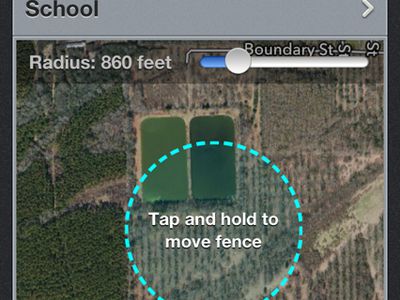
Windows Rebirth Techniques: Three Simple Resets

Windows Rebirth Techniques: Three Simple Resets
Factory resets are the nuclear solution for many Windows issues. If your computer is far slower than it once was, you have a malware infection that you can’t remove, or plan to sell your machine, a reset is the most convenient option.
Depending on your setup and installed version of Windows, you have a few different ways to factory reset a Windows laptop or desktop. We’ll show you how to reset a Windows 11, 10, or earlier computer as easily as possible.
Disclaimer: This post includes affiliate links
If you click on a link and make a purchase, I may receive a commission at no extra cost to you.
Before You Reset Windows, Make Sure You Back Up
Before we look at how to factory reset Windows, you should ensure you have a recent backup of your data. Performing a factory reset will wipe out all your installed programs, and in some cases, your files. You don’t want to leave anything behind.
Make sure you know what to back up from your computer , then see our Windows data backup guide . Once you have a safe copy of everything, you can proceed with reinstalling Windows.
1. How to Factory Reset Windows 10 or Windows 11 Using the Built-In Method
Factory resetting Windows was once an inconvenient process, but Microsoft introduced a much easier way to do so starting in Windows 8. As this is also included in Windows 10 and Windows 11, it’s the best way to factory reset a Windows computer in most cases.
To access this Windows reinstall option on Windows 10, head to Settings > Update & Security > Recovery. You’ll see a Reset this PC header; click the Get started button underneath this to begin.
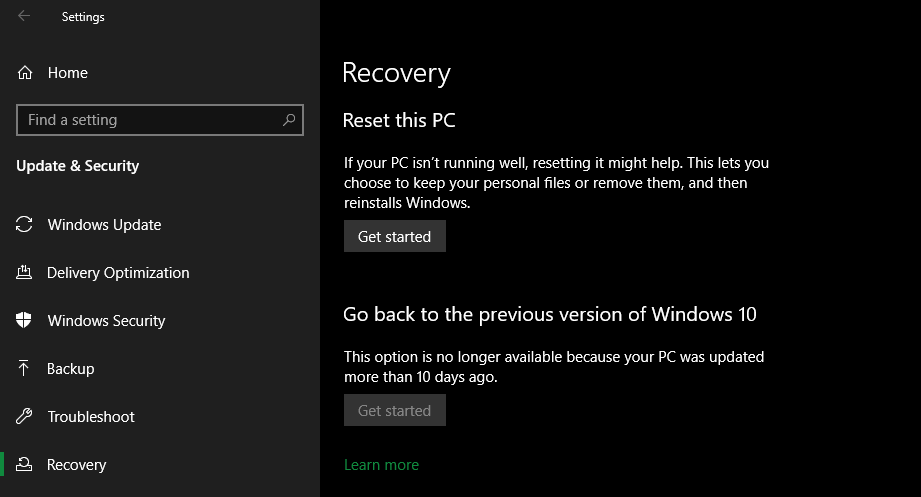
If you’re on Windows 11, head to Settings > System > Recovery. Click Reset PC next to Reset this PC to get started. The steps from here are the same for Windows 11 and Windows 10. If you run into trouble, see how to factory reset Windows 11 without an admin password .
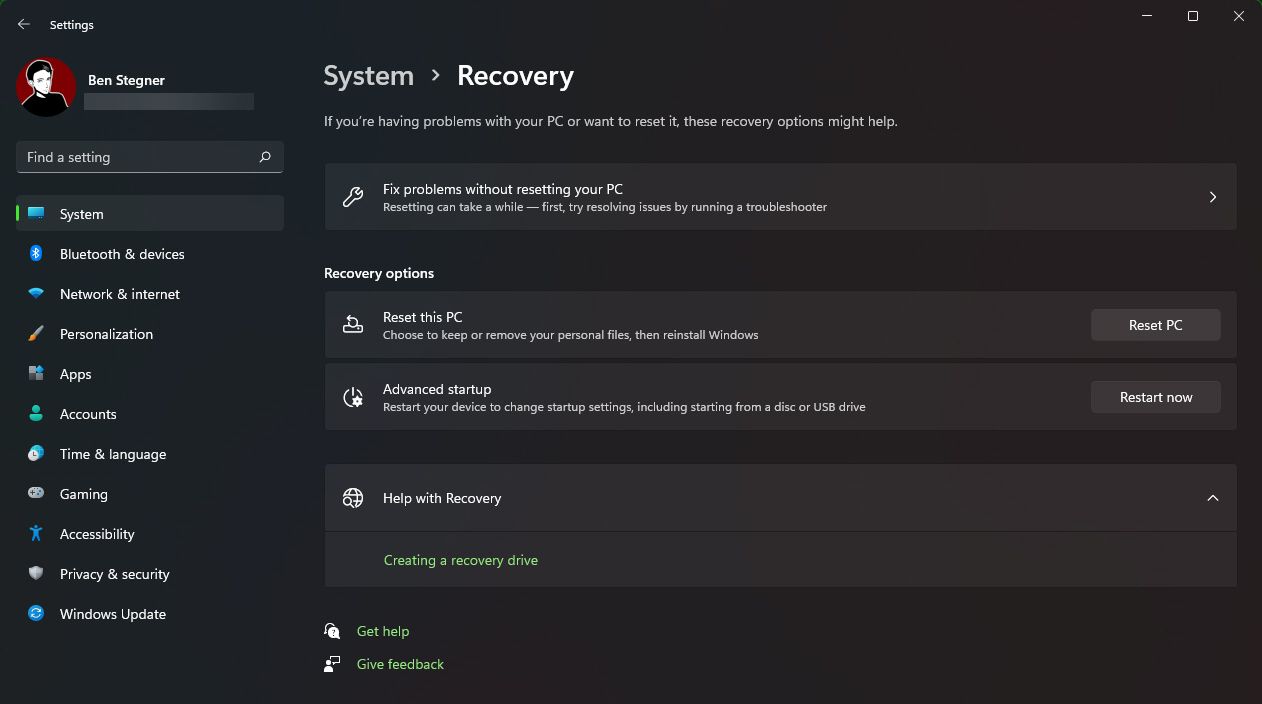
Keep Your Files or Remove Everything?
You’ll have two initial options to choose from when you factory reset Windows 10 or 11 this way: Keep my files or Remove everything.
Picking Keep my files sets your OS options back to default and removes all your installed apps (such as browsers, office software, and games), but keeps your files (like documents and music).
True to its name, Remove everything is a full factory reset: it puts all options back to factory defaults and removes your files and apps. Afterward, Windows will be like it is on a brand-new computer.
Though the Keep my files option will retain your personal data, you should still back up before using it in case something goes wrong.
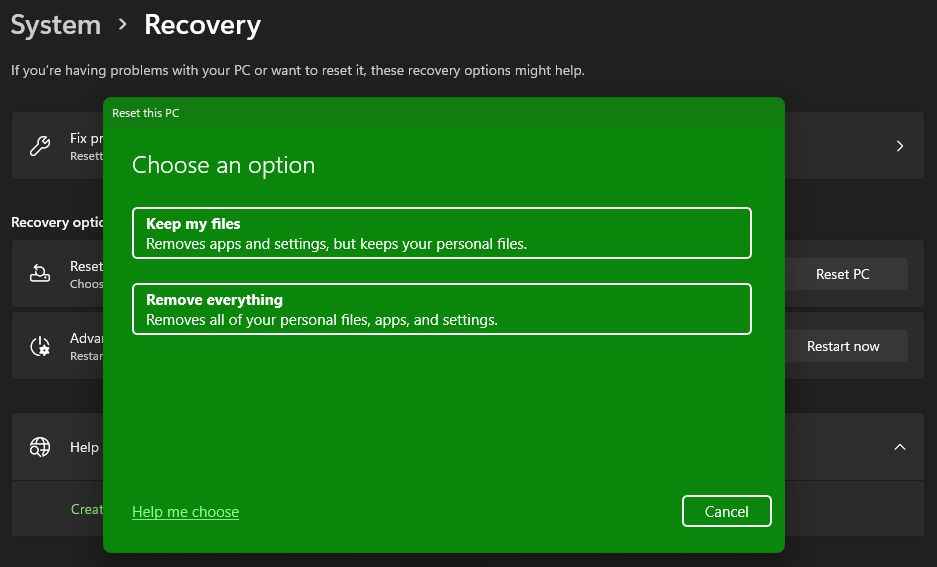
Cloud Download vs. Local Reinstall
You’ll next have to choose how you want to reinstall Windows. There are two ways: Cloud download or Local reinstall.
Local reinstall uses files on your current system to construct a fresh copy of Windows. While it saves you from having to download any files from the internet, it also won’t work if your Windows installation is corrupted.
With Cloud download, the process will instead download a fresh copy of Windows from Microsoft over the internet. This reinstalls the version of Windows 10 or 11 you’re currently running (plus any minor updates), so it won’t upgrade you to a newer feature update.
Downloading Windows takes several gigabytes of data, so take care if you’re on a limited connection. If you have a speedy internet connection, though, this option can be faster than the local reinstall since it doesn’t have to sort through so much data.
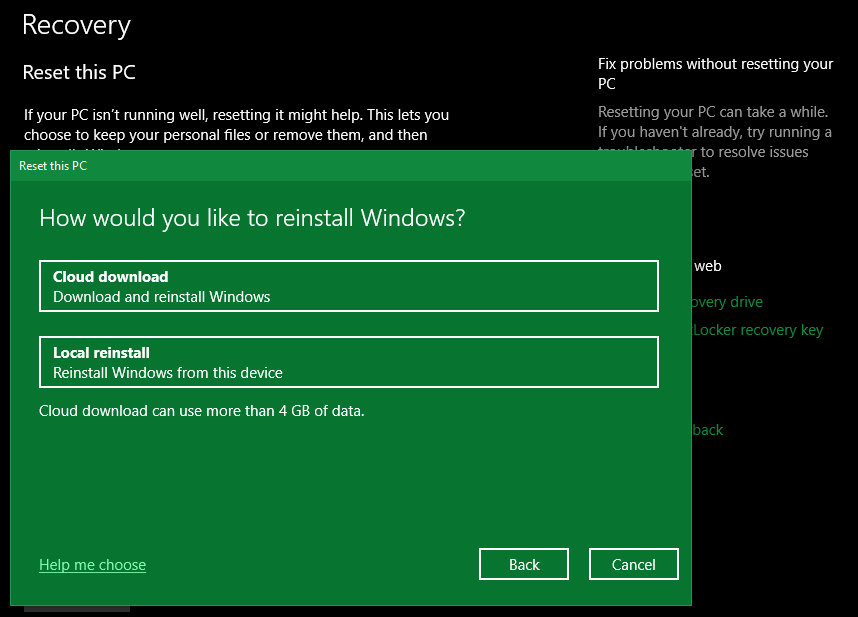
Options When Resetting Windows 10 and 11
Next, you’ll see an Additional settings menu that has a Current settings section, containing a summary of what you’ve chosen to do so far. There’s also a Change settings link you can click for more options.
If you chose Keep my files earlier, you’ll have two options under Change settings. One is a redundant Download Windows? toggle for cloud or local reinstall.
The other is Restore preinstalled apps? Turn this off and your factory reset won’t include any apps that came with your initial setup. Disabling it is a good way to avoid Windows bloatware from your hardware manufacturer.
There are additional choices when you pick Remove everything. Enabling Clean data? will obliterate everything on the drive to reduce the chance of someone recovering it later. Though this process takes some time, you should use it if you’re getting rid of your computer. It’s not necessary if you’re keeping your machine.
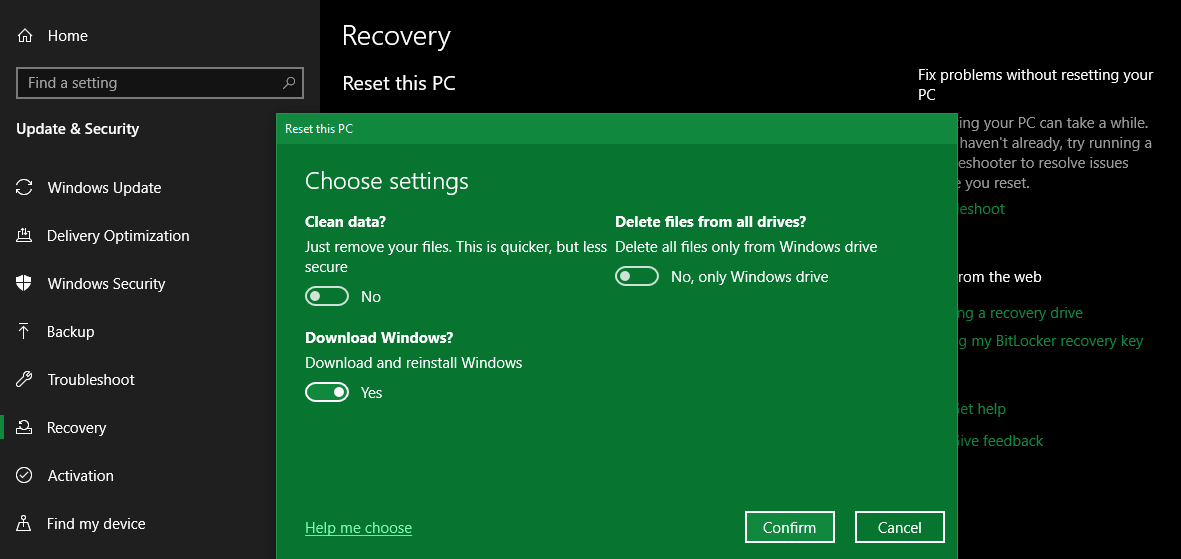
Turn on Delete files from all drives? to erase everything on all drives you have connected to your computer. This includes external hard drives and recovery drives. Because you probably have backups and other important files on those drives, you shouldn’t use this unless you want to permanently erase everything associated with your computer. Be careful with this option!
Confirm the Windows Factory Reset Operation
Click Confirm when you’re satisfied with the options above. The final screen before you start the factory reset is titled Ready to reset this PC.
You’ll see a list of actions that the process will perform. Click View apps that will be removed if you want to double-check which programs are affected by this process.
Finally, confirm the operation by clicking Reset, then wait for the process to complete. If you’re factory resetting a laptop, make sure you plug it in to avoid losing power during the operation. You’ll need to walk through the Windows setup procedure again once it’s done.
Make sure you take the recommended steps after reinstalling Windows 10 if you’re sticking with that OS.
2. Reinstall Windows Manually Using Windows Installation Media
If you’re not using Windows 10 or 11, want to factory reset Windows 10 or 11 without the Settings menu, or don’t want to use the other methods for some reason, you can always factory reset Windows using installation media. This allows you to install a fresh copy of Windows on your computer and wipe out everything currently on it.
Windows 11 users should follow our guide to creating a Windows 11 bootable drive , which you can then install a new copy of Windows from.
For Windows 10, see how to install Windows 10 from a bootable USB drive . This will walk you through the process of loading the Windows 10 installer on a flash drive, booting from it, and erasing your current installation with a fresh copy. This is free and easy, as long as you have a spare USB drive.
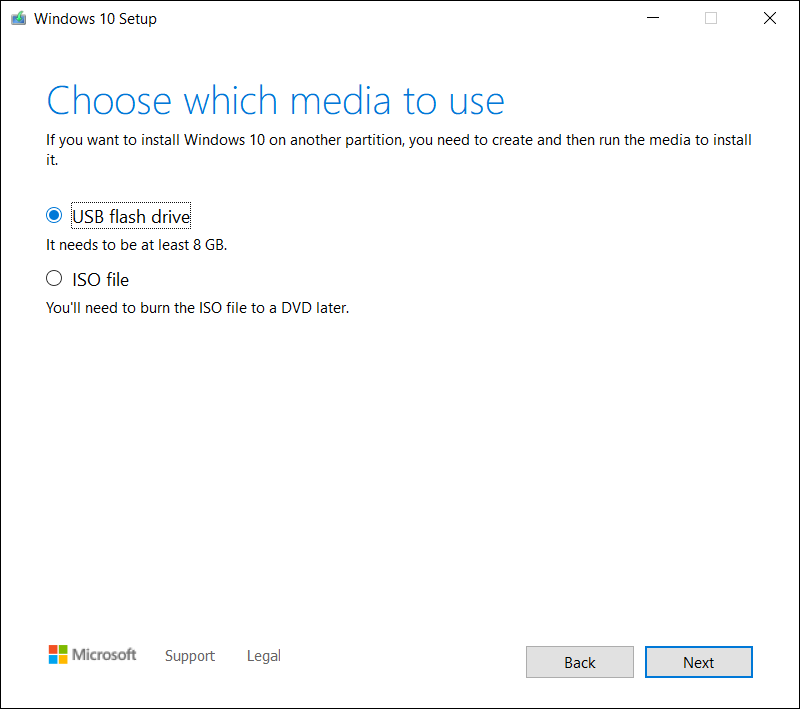
If you need to reinstall Windows 8.1 from scratch for some reason, you can use Microsoft’s Windows 8.1 download tool . This lets you download an ISO to burn onto a flash drive or DVD so you can reinstall Windows. Simply insert the USB drive or disc containing your installation media, then boot from the removable device . You’ll be greeted with the Windows setup screen, which you can proceed through to install a clean copy. Remember that doing this will remove everything currently on the drive where you install Windows.
Since Windows 7 has been out of support for years, Microsoft no longer offers an official Windows 7 download. We recommend that you upgrade to a modern version of Windows ; don’t download Windows 7 from a random website, as it may contain malware.
Note that the methods in #1 above allow you to reinstall Windows in effectively the same way without manually creating a USB installer, so they’re much more convenient.
3. Factory Reset Windows 10 or 11 From Boot Using Advanced Methods
While the methods listed above will work for most users, there are a few advanced ways to reset Windows, if you need them.
To run a Windows factory reset from boot (in case you can’t get into Windows normally, for example), you can start a factory reset from the Advanced Startup menu.
To launch this menu if Windows is working properly, on Windows 10, visit Settings > Update & Security > Recovery. Under the Advanced startup section, click Restart now to reboot into Advanced Startup. On Windows 11, go to Settings > System > Recovery and click Restart Now next to Advanced Startup.
Alternatively, you can open the Start menu and expand the power menu there, then hold down the Shift key as you click the Restart button. In case you can’t do either of these, try pressing F11 as you boot, which will open Advanced Startup on some systems. Failing this, Windows will launch Advanced Startup on its own after three failed boots—allowing you to reset from boot if there’s a major problem.
Once Advanced Startup is open, choose Troubleshoot, then select Reset This PC to walk through nearly the same factory reset procedure as #1 above. You can pick Advanced options for more choices, but none of them let you factory reset Windows 10 or 11 unless you have a saved system image.
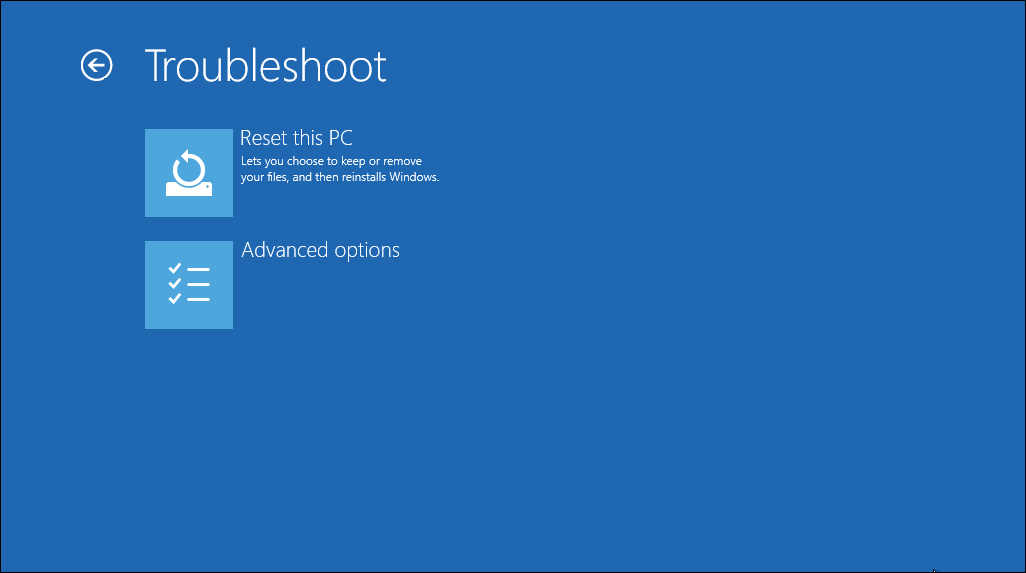
Otherwise, you may be able to boot into the BIOS and directly load the recovery partition on your hard drive, if your PC manufacturer included one. However, if you factory reset with this method, you’ll reinstall all the manufacturer bloatware. While it’s not ideal, it can work if you have no other options.
You can also type “create a recovery drive” into the Start menu to access a tool that lets you make your own. However, this requires a fair bit of space, and you’ll have to do it before you have a problem. If you haven’t already made one, you’re best off making a new Windows install disk, as described in #2.
To cover all the bases: there is no way to factory reset Windows from the BIOS. While you can reset the BIOS to its default options, you can’t factory reset Windows itself through the BIOS. There’s also no way to factory reset your laptop without turning it on; you need power to perform all the above operations.
If You’re on an Older Version of Windows 10
Microsoft used to offer an option called Fresh Start for resetting your Windows 10 PC. Starting with Windows 10 version 2004, this option was replaced by the process described above.
To check if you’re on an old version, go to the Settings > Update & Security > Recovery page, then click the Learn how to start fresh with a clean installation of Windows link at the bottom. This will open the Windows Security app, showing the Fresh start option. Click Get started to proceed.
If you’re on at least Windows 10 version 2004, clicking this link text will open Microsoft’s Fresh Start page in your browser and recommend that you use method #1 above to reset. However, if you’re on a version of Windows 10 that still offers this, you need to install the latest version of Windows as soon as you can to keep your PC secure.
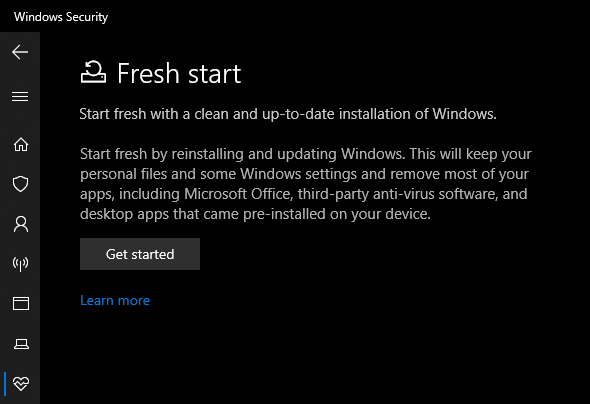
Now You Know How to Factory Reset Your Windows Computer
You have several options for factory resetting a Windows computer. On Windows 10 or 11, the built-in factory reset option is quick and easy. If you prefer, all users of modern Windows can download an image from Microsoft and perform a clean installation that way.
Whether you need to fully reset your laptop before you sell it, or just want to refresh your PC for a performance boost, one of these methods will have you on your way to resetting Windows as fast as possible.
Depending on your setup and installed version of Windows, you have a few different ways to factory reset a Windows laptop or desktop. We’ll show you how to reset a Windows 11, 10, or earlier computer as easily as possible.
Also read:
- [New] 2024 Approved Top Cycling Sims Worth Your Time
- [Updated] Boost Video Influence Techniques for Exceptional Client Spotlights
- 2024 Approved Quick, Quirky, and Funny Creating Memes Anytime
- Avoiding Common Pitfalls: Expert Tips for Choosing a High-Quality Selfie Stick
- Change Location on Yik Yak For your Xiaomi Redmi 13C 5G to Enjoy More Fun | Dr.fone
- Easy Methods for Changing Your Profile Image on Discord
- Essential Info on Keygen Malware & Effective Windows Defense Techniques
- Full Guide on Mirroring Your Vivo Y36 to Your PC/Mac | Dr.fone
- How to Prolong Pin Length, Strengthen Windows 11 Security
- Identifying IP & MAC via Windows PowerShell
- In 2024, Unparalleled Live TV Experience with Local Channels
- Perfecting the Art of Virtualizing Windows 11 in VMware
- Quick Solutions to Reactivate Your iPhone/iPad's Predictive Emoji Feature
- Top 7 FREE Windows Devices for Seamless Viewing
- Win Strategies for Persistent Hibernate Issues
- Windows Hello Exposed: Is Your Biometric Data Safe?
- Title: Windows Rebirth Techniques: Three Simple Resets
- Author: Joseph
- Created at : 2025-02-27 06:33:41
- Updated at : 2025-03-01 16:01:45
- Link: https://windows11.techidaily.com/windows-rebirth-techniques-three-simple-resets/
- License: This work is licensed under CC BY-NC-SA 4.0.